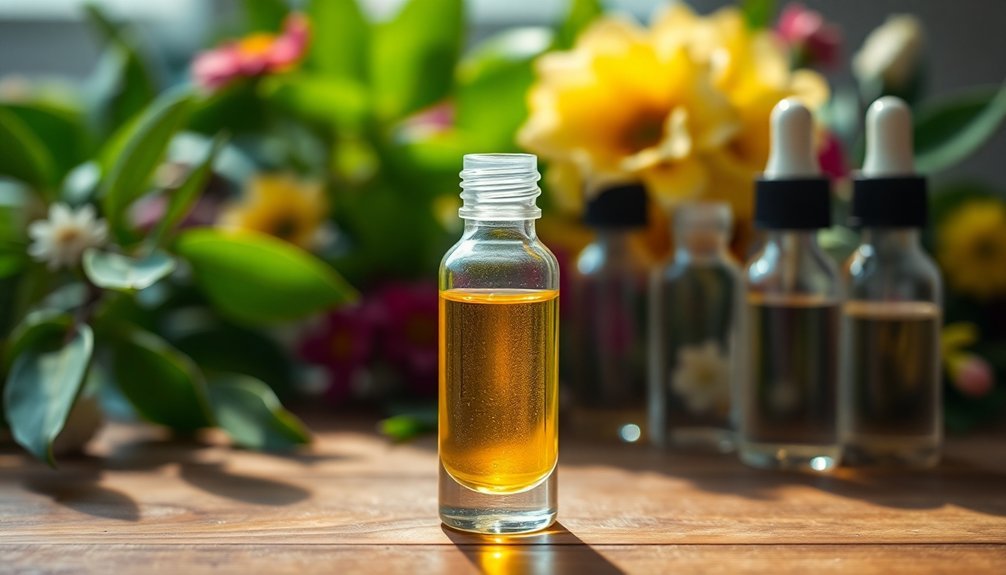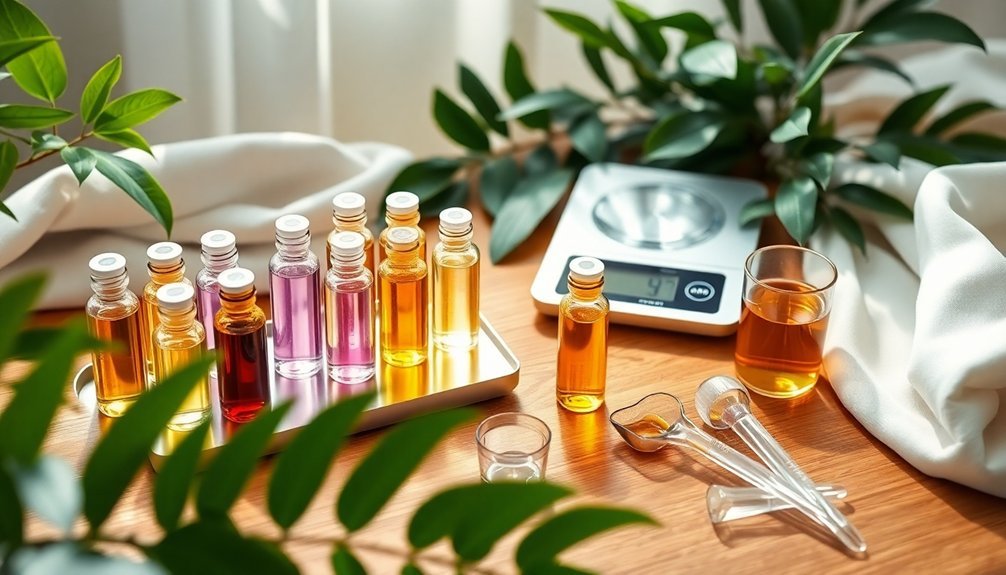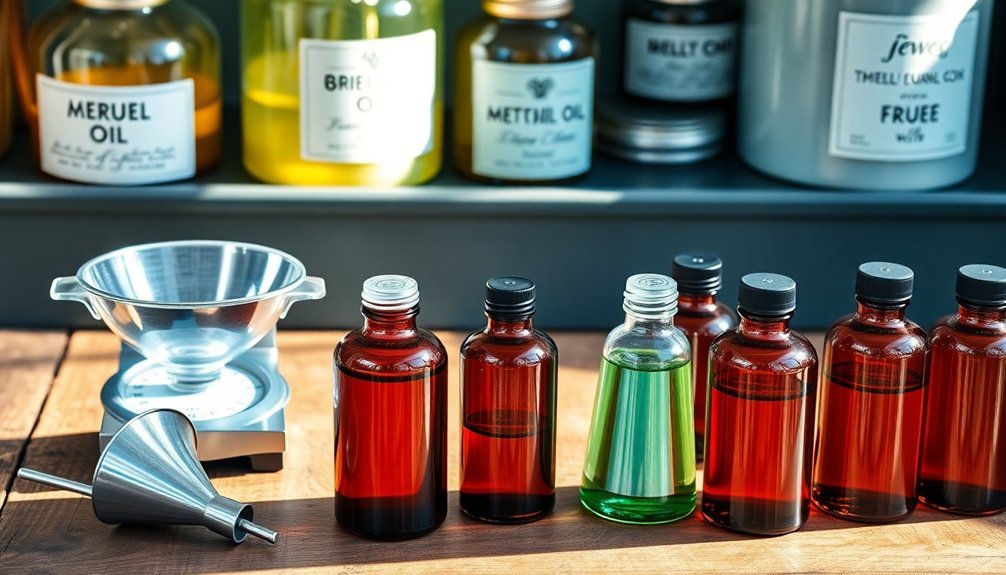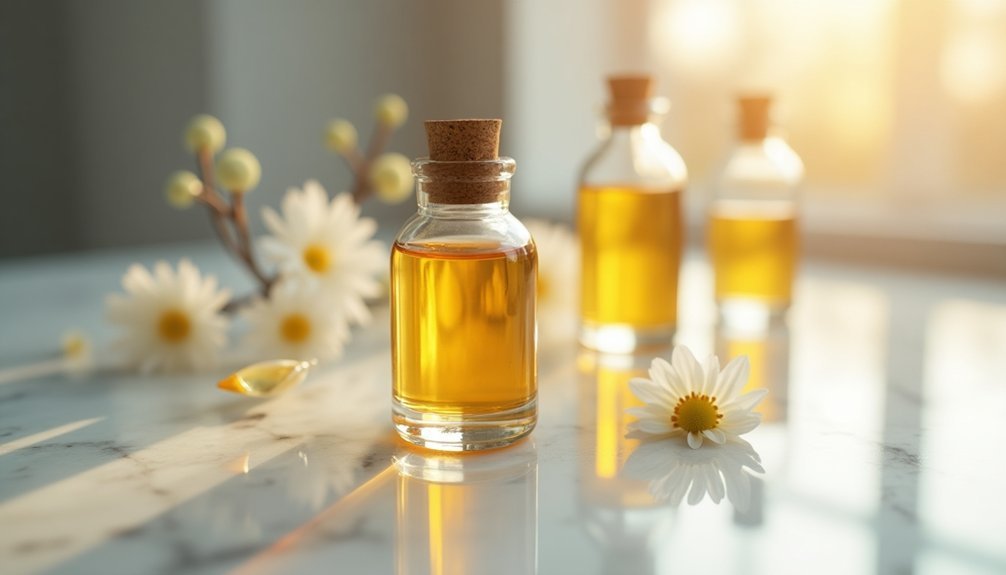To dilute raw perfume oils, you'll need amber glass bottles, measuring tools, and a carrier like perfumer's alcohol or fractionated coconut oil. Mix your oils in sequence: heart notes, base notes, then top notes. Use a 10% dilution ratio as a starting point, carefully weighing your concentrate before blending. Let your mixture mature for at least 48 hours, ideally six weeks, in a dark bottle. The complete process reveals essential techniques for achieving professional results.
Understanding Raw Perfume Oil Properties

While many fragrance enthusiasts are familiar with traditional alcohol-based perfumes, raw perfume oils offer distinct advantages due to their concentrated nature.
You'll find these oils deliver a purer, more intense fragrance experience without alcohol's distorting effects, allowing the true essence of the scent to unfold naturally on your skin.
When you apply raw perfume oils, they work harmoniously with your skin's chemistry, creating a personalized scent that lasts longer than conventional fragrances.
The oils blend with your natural body heat at pulse points, gradually releasing their complex notes throughout the day. These oils enable bespoke fragrance combinations through layering different scents together.
You'll need only a small amount since they're highly concentrated, making them cost-effective.
Plus, they're gentler on your skin, as they lack the drying effects of alcohol and provide moisturizing benefits through their natural base oils.
Essential Tools and Materials for Dilution
You'll need accurate measuring tools like scales, beakers, and pipettes to guarantee precise dilution ratios when working with raw perfume oils.
Your storage setup should include amber glass bottles and properly sealed containers to protect your diluted perfumes from light and air exposure.
Safety equipment, including gloves and protective eyewear, is essential when handling concentrated oils and alcohol-based solutions.
Having perfumer's alcohol readily available as your primary solvent is crucial for achieving proper dilutions of your raw materials.
Precision Measuring Equipment Required
Accurate measuring equipment forms the foundation of successful perfume dilution.
You'll need a precise scale that measures down to 0.01g to guarantee your dilutions are consistent and reliable.
If you're just starting out, a jewelry scale under £10 can serve as a good entry point. However, if you're planning to work professionally, you'll want to invest in a proper lab balance for enhanced accuracy.
Before each measurement, make certain to calibrate your scale and set it to zero.
Always use weight measurements rather than volume, and stick to grams as your standard unit. This consistency will help you avoid errors in your dilutions.
Don't forget to keep your scale clean and protected from spills or damage, as precision equipment requires careful maintenance to maintain its accuracy.
Using perfumers alcohol for dilutions provides optimal results when creating alcohol-based perfume sprays.
Storage Containers and Bottles
Beyond precise measurements, proper storage containers play a key role in maintaining your diluted perfume oils.
You'll want to use dark glass bottles, particularly cobalt or amber, as they protect your oils from UV rays and heat degradation. While plastic bottles can work for travel, they'll need frequent replacement due to degradation from oil contact.
Store your bottles in a cool, dry, dark place, away from direct sunlight and heat sources. You can use your fridge for consistent temperature control.
As you use your oils, transfer them to smaller bottles to minimize oxygen exposure. Don't forget to label each container clearly and check them regularly for signs of leakage or degradation.
Always make certain your bottles are clean before use and sealed properly to prevent oxidation and maintain the quality of your diluted perfume oils.
Safety Gear Essentials
Proper safety gear and equipment form the foundation of responsible perfume oil dilution.
You'll need protective gloves to prevent skin contact with concentrated oils and potential irritants. Keep safety data sheets handy for each material you're working with, and verify you have a first aid kit nearby for emergencies.
- Wear chemical-resistant gloves that cover your wrists and forearms when handling raw perfume oils.
- Use protective eyewear to shield against accidental splashes.
- Keep a face mask with appropriate filters ready for working with strong-smelling materials.
Your safety equipment should always be in good condition and easily accessible.
Store clean gloves and goggles in a designated area of your workspace, and regularly check that your protective gear hasn't degraded or become compromised through use.
Step-by-Step Dilution Process
Successfully diluting raw perfume oils requires a systematic approach and careful attention to detail.
First, you'll need to gather your clean equipment, including a beaker, glass stirrer, and amber bottle. Verify everything's sterile to maintain quality.
Start by mixing your essences in the proper sequence: heart notes, base notes, and top notes.
Weigh your concentrate carefully, then blend it with any additional fragrance oils you're using.
Next, add your carrier agent – typically perfumer's alcohol or fractionated coconut oil – to achieve your desired dilution ratio.
Don't use water with essential oils, as they won't mix properly.
Let your mixture mature in a dark amber bottle for at least 48 hours, though six weeks is ideal.
Remember to swirl periodically.
Finally, filter the mature mixture before transferring it to your final perfume bottle.
Common Dilution Ratios and Calculations

Understanding dilution ratios forms the foundation of professional perfume creation. You'll need to master the basic percentages, starting with the most common 10% dilution for standard materials. For stronger ingredients like Ethyl Vanillin, stick to 1% dilution.
When creating specific fragrance types, follow industry-standard concentrations: Eau de Parfum uses 10-20%, Eau de Toilette 5-10%, and Extrait 15-30%.
- Essential oils in Eau Fraiche require minimal concentration (1-3%)
- Body sprays need light dilution (0.5-1%)
- Solid perfumes demand higher concentration (20-45%)
Calculate your dilutions accurately using this formula: (percentage/100) x total weight = amount of raw material.
For precise measurements, always use a scale and consider converting between units when necessary. Remember that different applications require different concentrations, so adjust accordingly.
Safety Guidelines and Best Practices
When working with raw perfume oils, safety must be your top priority. Never apply undiluted oils directly to your skin, as they can cause severe irritation, burns, or allergic reactions. Always use proper diluting agents like perfumer's alcohol for alcohol-based perfumes or carrier oils for aromatherapy blends.
You'll need accurate measurements using a scale rather than drops, and make certain you're using weight-to-weight ratios for professional results.
When handling solid or resinous materials, use gentle heat to facilitate dilution. Pre-dilute tricky materials to simplify your blending process and reduce errors.
If you're working with multiple ingredients, add them in order of volatility to guarantee stable distribution. Remember to follow safety guidelines from organizations like the Environmental Working Group for the best protection.
Storage and Handling of Diluted Oils

Proper storage of diluted perfume oils plays an essential role in preserving their quality and extending their lifespan. Store your oils in dark amber or cobalt blue glass bottles, avoiding plastic containers that can react with the oils.
Place them in a cool, dry, dark location away from direct sunlight and heat sources – a cupboard or drawer works perfectly. You can even use your fridge, just remember to let the oils warm up for 1-2 hours before use.
- Dark glass bottles protect against harmful UV rays
- Airtight containers prevent unwanted oxidation
- Cool, dark storage spaces maintain oil integrity
To minimize oxidation, transfer your oils to smaller bottles as the liquid level decreases, and always keep them tightly sealed.
Monitor your oils by tracking opening dates and checking for any changes in color, consistency, or aroma that might indicate degradation.
Frequently Asked Questions
Can I Remix or Adjust a Dilution if I Made It Too Strong?
Yes, you can adjust a dilution that's too strong by adding more solvent. You'll need to calculate the additional amount needed to reach your target percentage, using a scale for accurate measurements.
How Long Do Diluted Perfume Oils Typically Maintain Their Scent Profile?
Your diluted perfume oils can maintain their scent profile for 6-12 months when properly stored. You'll notice the best longevity with oil-based dilutions, while alcohol-based ones may lose potency faster.
What Causes Cloudiness in Diluted Oils and Is It Harmful?
Your diluted oils can become cloudy from water interaction, temperature changes, poor formulation, or impure ingredients. While cloudiness isn't harmful, it indicates your mixture isn't properly solubilized or stabilized.
Can I Blend Different Diluted Oils Together to Create New Scents?
Yes, you can blend different diluted oils to create unique fragrances. Make sure they're all at consistent dilution ratios (usually 10%) and follow the 30/50/20 rule for top, middle, and base notes.
Does Temperature Affect the Dilution Process or Final Scent?
Yes, temperature markedly affects your dilution process and final scent. You'll find that proper temperature control helps ingredients blend better, speeds up precipitation of unwanted materials, and maintains the fragrance's intended olfactory profile.
In Summary
Now you're ready to start diluting your raw perfume oils with confidence. Whether you're creating personal fragrances or developing products, remember to maintain proper safety measures, keep detailed records of your ratios, and store your diluted oils correctly. You'll find that with practice, you'll develop a keen sense for creating the perfect dilutions that suit your specific needs and preferences.





Leave a Reply